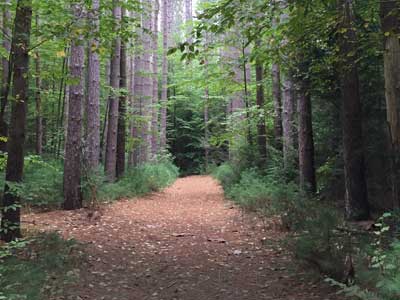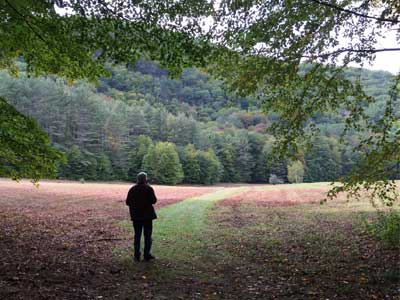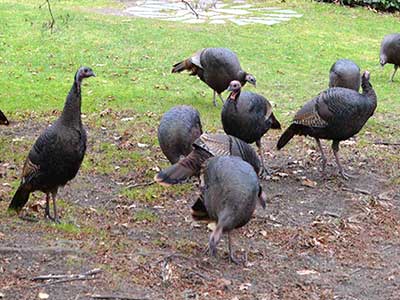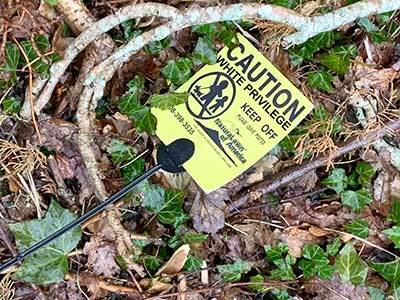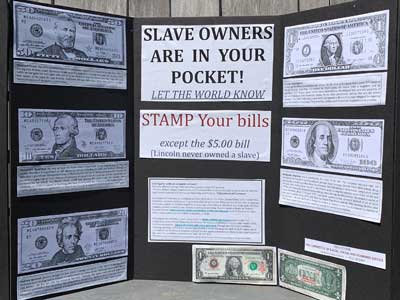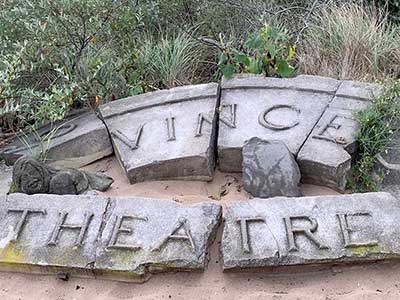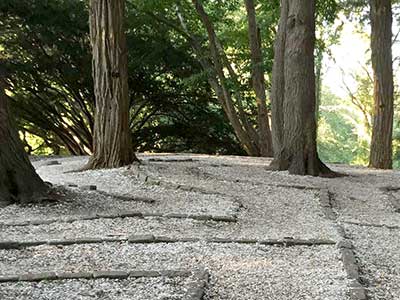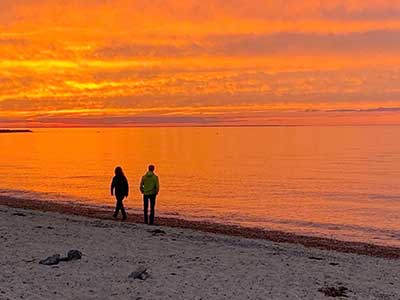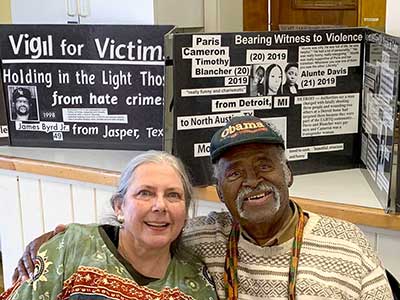by Tim Wise | November 2021
Worried that racial justice activism might embolden progressives pushing for meaningful equity initiatives in policing, the workplace, and elsewhere, conservatives latched on to this strategy — attacking classroom discussions of racism as “indoctrination” — so as to limit awareness of racial injustice among youth, energized by last summer’s events. The right claims anti-racist curriculum is about guilt-tripping white students. One of the primary weapons in the rhetorical arsenal of this advancing army has been the claim that anti-racist curriculum seeks to make white children feel guilt and shame because of their skin color.
TAGS: [Individual Change] [2020’s] [Anti-Racism] [White Supremacy] [White Culture] [White Privilege] [Social Justice] [Policing] [Employment] [White Fragility/Tears] [History] [Teachers] [Systemic Racism] [Slavery] [Black Lives Matter] [Indigenous] [Advocacy][CRT]
Resource Links Tagged with "White Culture"
BLACK LIVES MATTER; How White Feminism Failed in the Age of Trayvon Martin
by Rachel Cargle | February 2022
It was the Women’s March on January 21, 2017, that opened my eyes to the racist underbelly of the feminist movement. I was so eager to be a part of what was happening that I partnered with a friend of mine to organize a busload of people to leave from Manhattan’s Lower East Side for our nation’s capital at 4 a.m that day. … Admittedly, it didn’t dawn on me right away. It wasn’t until weeks after the march — after I was called in by a group of Black peers inviting me to question the ways white feminism gave space for my Blackness — that I took a pause to really think it through. At the march, there was an abundance of pink pussy hats but a disturbing lack of Black people among the millions chanting. It was alarming to consider, especially since the country remained in the midst of racial unrest. Audre Lorde once said, “I am a Black Feminist. I mean I recognize that my power as well as my primary oppressions come as a result of my blackness as well as my womaness, and therefore my struggles on both of these fronts are inseparable.” Years after she spoke these words, I felt the same tense inseparability of my doubly oppressed identity.
TAGS: [Individual Change] [2020’s] [Systemic Racism] [White Supremacy] [White Culture] [White Privilege] [White Blindness] [Anti-Racism] [Social Justice] [Racial Terrorism] [Policing] [Intersectionality] [Black Lives Matter] [Advocacy]
America’s Gun Obsession is Rooted in Slavery; A Series of Slave Revolts Terrified White Residents and Helped Fuel the Rationale for Gun Ownership
by Carol Anderson | June 2021
For too long, the second amendment has been portrayed with a founding fathers aura swaddled in the stars and stripes. But “a well-regulated militia” wasn’t, as the story goes, about how valiant and effective the militias were in repelling the British. George Washington was disgusted with their lack of fighting ability and the way the men would just cut and run from battling against a professional army. Nor was the militia reliable as a force to uphold the law. In Shays’ Rebellion, bands of armed white men, who were in the state’s militia, attacked the Massachusetts government because of foreclosures and debt seizures, demonstrating, again, how unreliable the militia were. Boston merchants had to hire mercenaries to put down the rebellion.
On the other hand, where the militia had been steadfast was in controlling the enslaved Black population. Access to guns for white people was essential for this function.
TAGS: [Racial Terrorism] [2020’s] [Economics] [Justice System] [White Supremacy] [White Culture] [White Privilege] [Politics] [White Blindness] [White Defensiveness] [History] [Black Lives Matter] [Social Justice] [Systemic Racism] [Slavery] [Policing] [Silencing POC]
The Re-Assassination of Martin Luther King, Jr.
by Wendell Griffen | January 2022
This year, the Arkansas Martin Luther King Jr. Commission, an agency of the Arkansas Department of Education, has invited an un-reconstructed Southern Baptist preacher, right wing politician, and Fox News pundit named Mike Huckabee to deliver a “keynote address” during what it terms an “inter-faith prayer breakfast” on the King holiday (January 17). Attendance will be by invitation only. The event will be held at the Arkansas Governor’s Mansion.
TAGS: [Strategies] [2020’s] [History] [Systemic Racism] [Social Justice] [Role Model] [Politics] [Racial Terrorism] [Civil War] [Black Lives Matter] [White Supremacy] [White Culture] [Economics] [White Privilege] [White Blindness] [Intersectionality]
More than 1,700 Congressmen Once Enslaved Black People. This Is Who They Were, and How They Shaped the Nation.
by Julie Zauzmer Weil, Adrian Blanco and Leo Dominguez| January 2022
From the founding of the United States until long after the Civil War, hundreds of the elected leaders writing the nation’s laws were current or former slaveowners. More than 1,700 people who served in the U.S. Congress in the 18th, 19th and even 20th centuries owned human beings at some point in their lives, according to a Washington Post investigation of censuses and other historical records.
TAGS: [Racial Terrorism] [2020’s] [Civil War] [Slavery] [Politics] [Systemic Racism] [White Supremacy] [White Culture] [White Privilege] [White Blindness] [Justice System] [History] [Black Lives Matter] [Silencing POC] [Confederate Monuments] [Indigenous]
Native Americans and Mount Rushmore
by From the Collection: Native Americans | Date Unknown
The creation of Mount Rushmore is a story of struggle — and to some, desecration. The Black Hills are sacred to the Lakota Sioux, the original occupants of the area when white settlers arrived. For some, the four presidents carved in the hill are not without negative symbolism. The Sioux have never had much luck dealing with white men. In the Treaty of 1868, the U.S. government promised the Sioux territory that included the Black Hills in perpetuity. Perpetuity lasted only until gold was found in the mountains and prospectors migrated there in the 1870s. The federal government then forced the Sioux to relinquish the Black Hills portion of their reservation.These events fit the pattern of the late 19th century, a time of nearly constant conflict between the American government and Plains Indians. At his second presidential inauguration in 1873, Ulysses S. Grant reflected the attitudes of many whites when he said he favored a humane course to bring Native Americans “under the benign influences of education and civilization. It is either this or war of extermination.” Many of the land’s original occupants did not choose to assimilate; for them war, was the only option.”
TAGS: [Strategies] [Indigenous] [Racial Terrorism] [Systemic Racism] [Silencing POC] [White Supremacy] [White Culture] [White Blindness] [Politics] [Social Justice] [History] [White Privilege] [Prison System] [Art & Culture]
Opinion: Why Norman Rockwell Left Thanksgiving Americana behind
by Andrew L. Yarrow | November 2021
At this time of year, Norman Rockwell is best remembered for his iconic 1943 painting “Freedom From Want,” depicting a smiling White family gathered around a Thanksgiving turkey. But it is less well known that he decisively turned a corner just a few decades later, choosing to reject the airbrushed image of a nation implicitly populated with only happy, White, middle-class families.
TAGS: [Strategies] [2020’s] [Systemic Racism] [Prison System] [Policing] [Black Lives Matter] [Art & Culture] [White Supremacy] [White Culture] [White Privilege] [History] [Politics] [Social Justice]
The Lewis and Clark Expedition from an Indigenous Perspective; New Federal-Tribal Partnership Will Deepen the Corps of Discovery Journey with Stories from the Many Tribes Who Helped the Explorers Find Their Way
by Wil Phinney | November 2021
“If it wasn’t for Indians, Lewis and Clark probably wouldn’t have made it,” said Gail Chehak, tribal relations and outreach manager at the American Indian Alaska Native Tourism Association (AIANTA), which is collaborating with NPS to develop online itineraries to promote the tribes that intersected with Lewis and Clark on their way across what became the United States. The online guides will include tribal events and sites, designed to help attract visitors ranging from families and bicycle tours to international tourism. Importantly, the stories will reflect the expedition from an Indigenous perspective, as told by the descendants of those who encountered the explorers as they made their way west. Cultural and geo-tourism will be highlighted on two websites, LewisAndClark.travel and NativeAmerica.travel.
TAGS: [Collective Action] [2020’s] [Indigenous] [History] [Assumptions] [Myths] [White Culture]
Jim Crow Laws
by history.com Editors| Updated January 2022
Jim Crow laws were a collection of state and local statutes that legalized racial segregation. Named after a Black minstrel show character, the laws—which existed for about 100 years, from the post-Civil War era until 1968—were meant to marginalize African Americans by denying them the right to vote, hold jobs, get an education or other opportunities. Those who attempted to defy Jim Crow laws often faced arrest, fines, jail sentences, violence and death.
TAGS: [Racial Terrorism] [2020’s] [Systemic Racism] [Silencing POC] [Racial Covenants] [History] [Collective Action] [Denial] [Politics] [White Supremacy] [White Culture] [White Privilege] [Black Lives Matter] [Policing] [Prison System] [Housing] [Justice System] [Advocacy] [Role Model] [Definitions]
Penobscot Nation Members Do Not Want Ancestors’ Scalping Whitewashed; A new educational film produced by the tribe explains how settlers were encouraged to scalp natives for cash bounties.
by David Sharp | December 2021
Most Americans know about atrocities endured by Native Americans after the arrival of European settlers: wars, disease, stolen land. But they aren’t always taught the extent of the indiscriminate killings. Members of the Penobscot Nation in Maine have produced an educational film addressing how European settlers scalped — killed — Indigenous people during the British colonial era, spurred for decades by cash bounties and with the government’s blessing. “It was genocide,” said Dawn Neptune Adams, one of the three Penobscot Nation members featured in the film, called “Bounty.” She said the point of the effort isn’t to make any Americans feel defensive or blamed. The filmmakers say they simply want to ensure this history isn’t whitewashed by promoting a fuller understanding of the nation’s past. At the heart of the project is a chilling declaration by Spencer Phips, lieutenant governor of the Province of Massachusetts Bay.
TAGS: [Racial Terrorism] [2020’s] [Indigenous] [Systemic Racism] [History] [Social Justice] [White Supremacy] [White Privilege] [White Culture] [Politics] [Economics] [Teachers] [White Blindness]
The Indigenous Connection to the Underground Railroad
Submitted by Roy Finkenbine | June 2021
Most stories of the Underground Railroad follow the narrative of white people helping Black people escape slavery, but overlook the involvement of Indigenous allies who often risked their own lives to help freedom seekers cross into Canada safely. Historian Roy Finkenbine is among those rewriting that history. He’s working on a book tentatively called, Freedom Seekers in Indian Country, while teaching African American history at the University of Detroit Mercy. He spoke with Falen Johnson, host of Unreserved, about his research on Indigenous involvement in the Underground Railroad, and why he feels a moral obligation to write about it. What questions are you trying to answer in your upcoming book, Freedom Seekers in Indian Country? I’m looking at how and why Native Americans helped freedom seekers. How they helped includes providing sanctuary among their communities – often to boost their populations – and in assisting people to cross the border. They shared a kinship based on a common enemy, if we can use that term, in terms of white expansionism. Many groups like the Ojibwa referred to African-Americans as cousins and brothers. Peter Jones, a [Mississauga] missionary, said, and I’m paraphrasing here, “Negroes,” as he said, “have it even worse because of the iron bands of slavery. So we have an obligation to help.”
TAGS: [Assumptions] [2020’s] [Slavery] [Indigenous] [History] [Myths] [White Culture] [White Privilege] [White Supremacy] [Systemic Racism]
Time Will Not Heal: 5 Ways to Address the Inheritance of Black Poverty, Starting Now
by Richard V. Reeves | June 2021
In white families, poverty is almost never passed down “like a disease”. Our just-published paper shows that just 1.3% of whites are experiencing third-generation poverty. By comparison, more than one in five Black Americans (21.3%) are in the third generation of their family to be poor. (The full paper, co-authored with Scott Winship and Santiago Deambrosi of AEI as well as Christopher Pulliam and Ariel Gelrud Shiro from our own team, is “Long Shadows: The Black-white gap in multigenerational poverty”). Our paper represents the first attempt to analyze income mobility patterns across three generations, back to the Civil Rights era, and it is an empirical challenge. But the overall pattern is starkly clear. Black Americans are sixteen times more likely to be in the third generation of poverty, defined as the bottom fifth of the income distribution (i.e. less than around $48,000 a year for a family of four in today’s money).
TAGS: [Strategies] [2020’s] [Economics] [Systemic Racism] [Black Lives Matter] [Tips-Dos/Don’ts] [White Privilege] [White Culture] [White Supremacy] [History] [Social Justice] [Reparations] [Housing] [Indigenous] [Justice System]
The Grave of a Former Slave Turned Florida State Senator May Be Buried Under What’s Now A Tampa Parking Lot
by J.L. Cook | June 2021
As Juneteenth approaches, Tampa’s local NAACP wants the city to commit to finding the graves that once rested at College Hill Cemetery. Robert Meacham, who became a Florida state senator after being freed from slavery, is one of more than 1,200 people buried at a site that is now believed to be a parking lot for the Italian Club Cemetery in Tampa, Fla. According to the Tampa Bay Times, Meacham’s unmarked grave was located in the College Hill Cemetery for Blacks and Cubans–which has long been erased. In an effort to rectify this, the local NAACP branch in Tampa has challenged the city to commemorate Juneteenth by funding an archaeological survey of the Italian Club Cemetery lot to find out if Meacham’s body and others are there.
TAGS: [Collective Action] [2020’s] [History] [Systemic Racism] [White Culture] [White Supremacy] [White Privilege] [Politics] [Silencing POC] [Black Lives Matter] [Social Justice] [Slavery] [Accountability]
Why Issa Rae Says Diversity Questions Should Be Asked Of White People Who Run the Industry
by Jordan Simon | February 2020
“Every time there’s an interracial romance, it feels like it centers on whiteness, and it doesn’t have to,” the Insecure star said to Variety. “Just so you know, there are people who don’t procreate with just white people.” In the wake of Joaquin Phoenix’s speech at the BAFTAs calling out institutional racism and discrimination in Hollywood, Rae said it’s about time discussions on inclusion be asked of the white people make major decisions in the film and television industry. “I don’t feel like it’s up to me to answer those questions. Like, I’m doing the work. I’m out here. I’m employing who I need to employ, I’m telling the stories that I need to tell,” she said. “Those questions need to be asked to the powers-that-be. It needs to be asked to the white people who run this industry.”
TAGS: [Strategies] [2020’s] [Art & Culture] [White Culture] [Systemic Racism] [White Privilege] [Employment]
History of Institutional Racism in U.S. Public Schools
by Matthew Lynch | October 2019
Racial biases are not unknown to the history of the U.S. education system. Dating back to the 1800s, Native American children were taken from their homes and forced into boarding schools where they were pushed to abandon their native language and adopt a foreign religion. Education was used to assimilate these Native American children to White culture forcibly. This institutional racism created a belief that White culture was far better than the Native American Way. These racial biases expressed themselves with the Chinese in a different manner. Instead of forcing them to assimilate into the prescribed White educational system, Chinese-American children were barred completely from going to school. Later legislation stated they had a right to public education but segregated them into Chinese-only schools. Latinos faced the same fate as the Chinese in being methodically shut out from education. Latinos were later granted access to education under the ruling of a judge with a particular belief; the judge asserted that Latinos were of White descent and therefore above other minorities. In the American South, laws against African-Americans completely obstructed their ability to get an education. By law, it was illegal for an African-American to learn how to read and write. African-American communities had to turn to schools established by Quakers and Christians in order to get an education. But turmoil and violence would always find their white allies, forcing these schools to close their doors. Fear of uprising was palpable in these plantation states, and illiteracy became a weapon used against African-Americans. If African-Americans remained uneducated, plantation owners and Southern Whites believed, they would not revolt, maintaining the status quo of slavery.
TAGS: [Collective Action] [2010’s] [History] [Implicit Bias] [Indigenous] [White Culture] [Asian] [Black Lives Matter] [Quaker] [Faith-Based/Spiritual] [Slavery] [Social Justice] [White Privilege] [Teachers]
What Is Critical Race Theory, and Why Is It Under Attack?
by Steven Sawchuk | May 2021
Is “critical race theory” a way of understanding how American racism has shaped public policy, or a divisive discourse that pits people of color against white people? Liberals and conservatives are in sharp disagreement. The topic has exploded in the public arena this spring—especially in K-12, where numerous state legislatures are debating bills seeking to ban its use in the classroom. …Critical race theory is an academic concept that is more than 40 years old. The core idea is that racism is a social construct, and that it is not merely the product of individual bias or prejudice, but also something embedded in legal systems and policies. The basic tenets of critical race theory, or CRT, emerged out of a framework for legal analysis in the late 1970s and early 1980s created by legal scholars Derrick Bell, Kimberlé Crenshaw, and Richard Delgado, among others.
A good example is when, in the 1930s, government officials literally drew lines around areas deemed poor financial risks, often explicitly due to the racial composition of inhabitants. Banks subsequently refused to offer mortgages to Black people in those areas.
TAGS: [Strategies] [2020’s] [Housing] [Systemic Racism] [Politics] [Social Justice] [White Privilege] [White Supremacy] [White Culture] [White Defensiveness] [Slavery] [Definitions] [Racial Covenants] [Black Lives Matter] [Latino/a] [Teachers] [History]
The Bloody History of Anti-Asian Violence in the West; One of the Largest Mass Lynchings in the United States Targeted Chinese Immigrants in Los Angeles
*Paywall Alert
by Kevin Waite | May 2021
This year marks the 150th anniversary of one of the largest mass lynchings in American history. The carnage erupted in Los Angeles on October 24, 1871, when a frenzied mob of 500 people stormed into the city’s Chinese quarter. Some victims were shot and stabbed; others were hanged from makeshift gallows. By the end of the night, 19 mangled bodies lay in the streets of Los Angeles.Lynching is a term most often associated with violence against African Americans in the post-Civil War South. But racial hatred has never been quarantined to one American region or confined to a single ethnic group. In Los Angeles in 1871, the victims were Chinese immigrants. Their deaths were part of a wave of anti-Asian violence that swept across the 19th-century American West—and reverberates to this day.
TAGS: [Racial Terrorism] [2020’s] [White Supremacy] [White Culture] [History] [Asian] [Systemic Racism] [White Privilege] [Silencing POC]
Dr. West Throws The Gauntlet Down on White America; Brings Don Lemon to Tears
by Herb Dyer, Jr. | April 2021
In a recent appearance on Don Lemon’s CNN nightly talk fest, the good professor brought Lemon to tears with his analysis of the Derek Chauvin trial for that killer-cop’s (and his buddies) cold-blooded, public, callous and nonchalant — almost gleeful at times — lynching of George Floyd. Dr. West issued both a demand and a warning to white America and its police forces who do not seem to be able to stop killing black people. The gist of Dr. West’s comments is that black people today are not going to submit to teaching yet another generation of black children how to navigate their way through the white supremacist/white racist maze, its mental, physical (structural/institutional/systemic)and emotional roadblocks and obstacles placed everywhere and every time black people dare to act out their humanity.
TAGS: [Collective Action] [2020’s] [Politics] [Economics] [White Culture] [White Supremacy] [Systemic Racism]
8 Ways People of Color are Tokenized in Nonprofits
by Helen Kim Ho | September 2017
There’s a type of racism in the workplace many of us have personally witnessed, perpetrated or experienced: tokenism. Nowhere have I seen this play out more than in the nonprofit space. Tokenism is, simply, covert racism. Racism requires those in power to maintain their privilege by exercising social, economic and/or political muscle against people of color (POC). Tokenism achieves the same while giving those in power the appearance of being non-racist and even champions of diversity
TAGS: [Strategies] [2010’s] [White Privilege] [White Culture] [Systemic Racism] [Economics] [History] [Tips-Dos/Don’ts] [Social Justice] [Accountability] [White Supremacy] [White Blindness] [Black Lives Matter] [Asian] [Politics] [White Fragility/Tears] [Employment]
5 Phrases Your Black Friend Wishes You’d Stop Saying; If You Start Practicing Now, You Can Probably Eliminate These Words from Your Vocabulary by Black History Month
by Ajah Hales | January 2020 Statistically speaking, about 75% of White people don’t even have a Black friend, but on the off chance that you are one of the White people who do, I have a message for you from your (one) Black friend: Do better. In her New York Times...
Private Museums Could Face NAGPRA Scrutiny; Museums and Other Institutions that Accept Stimulus Funds Could Be Required to Repatriate Indigenous Artifacts and Remains
by Nanette Kelley | May 2021
Small museums and private institutions that accept federal CARES Act money or other stimulus funds could be forced to relinquish thousands of Indigenous items and ancestral remains now in their collections.
Under the Native American Grave Protection and Repatriation Act of 1990, museums or other institutions that accept federal funding must compile an inventory of Indigenous cultural items and initiate repatriation of the collections and remains to tribes or family members. At least two museums are now facing possible scrutiny – the nonprofit Favell Museum of Native American Artifacts and Contemporary Western Art in Klamath Falls, Oregon, and the End of the Trail Museum, which is connected to the Trees of Mystery gift shop in the redwood forest in Klamath, California.
TAGS: [Assumptions] [2020’s] [Indigenous] [Art & Culture] [Silencing POC] [History] [Politics] [White Supremacy] [White Culture] [Economics] [Systemic Racism] [Advocacy] [Social Justice]
‘Nomadland’ and the Supremacy of White People Problems; What’s the Strongest Liquid on Earth (and in Hollywood)? White Girl Tears
by Jeremy Helligar | January 2021
My 15-year-old niece recently floored her mother with some Black, bruising teen spirit: “What is the strongest liquid on earth?” she asked. Answer: “White girl tears.” It’s a revelation that has haunted me since my sister-in-law shared it with me. They live minutes away from Hollywood, a place on earth where hallowed White women have been crying themselves to Oscars for nearly a century. In 92 years of Academy Awards, Halle Berry remains the only Black woman whose tears have been strong enough to score a gong for Best Performance by an Actress in a Leading Role. Only 11 others have been nominated in the category, none more than once.
TAGS: [Individual Change] [2020’s] [White Fragility/Tears] [Art & Culture] [Asian] [Politics] [White Culture] [White Blindness] [White Privilege] [Black Lives Matter] [Latino/a] [Economics]
Historical Foundations Of Race
by David R. Roediger | Date Unknown
The term “race,” used infrequently before the 1500s, was used to identify groups of people with a kinship or group connection… The modern-day use of the term “race” is a human invention. The world got along without race for the overwhelming majority of its history. The U.S. has never been without it. Race is a human-invented, shorthand term used to describe and categorize people into various social groups based on characteristics like skin color, physical features, and genetic heredity. Race, while not a valid biological concept, is a real social construction that gives or denies benefits and privileges. American society developed the notion of race early in its formation to justify its new economic system of capitalism, which depended on the institution of forced labor, especially the enslavement of African peoples. To more accurately understand how race and its counterpart, racism, are woven into the very fabric of American society, we must explore the history of how race, white privilege, and anti-blackness came to be.
TAGS: [Strategies] [White Privilege] [Systemic Racism] [History] [Slavery] [Definitions] [White Supremacy] [White Culture] [Indigenous] [Economics]
Slave Traders Knew Exactly What They Were Doing; A New History of Three 19th-Century Human Traffickers Explodes All the Old Excuses
by Rebecca Onion | April 2021
The Ledger and the Chain tells the story of how these three men profited from the United States’ decision to outlaw the foreign slave trade, in 1808. The change, of course, did not put an end to slavery inside the United States, and because the slaveholding states of the Upper South were finding that their land was increasingly difficult to work after decades of tobacco cultivation, they profited by selling people further South, where cotton and sugar production was booming. …
This dynamic is most visible in the traders’ letters discussing teenage girls who were sold as sex slaves. In trading these young women, identifiable in documentation by their much-higher-than-usual prices (and, sometimes, by the traders’ explicit discussion of their likelihood to sell for those purposes), Franklin, Armfield, and Ballard prided themselves on their ability to know what buyers might want—their success “speculating on the erotic desires of slaveholders.” They also raped such women, themselves; Rothman found many ribald references to those activities in their own correspondence, interspersed with discussions of everyday business matters.
TAGS: [Racial Terrorism] [2020’s] [Slavery] [History] [Systemic Racism] [Black Lives Matter] [White Supremacy] [White Culture] [White Privilege] [Social Justice] [Politics]
Return the National Parks to the Tribes; The Jewels of America’s Landscape Should Belong to America’s Original Peoples.
by David Treuer | April 2021
The American story of “the Indian” is one of staggering loss. Some estimates put the original Indigenous population of what would become the contiguous United States between 5 million and 15 million at the time of first contact. By 1890, around the time America began creating national parks in earnest, roughly 250,000 Native people were still alive. In 1491, Native people controlled all of the 2.4 billion acres that would become the United States. Now we control about 56 million acres, or roughly 2 percent. And yet we remain, and some of us have stayed stubbornly near the parks, preserving our attachment to them. Grand Canyon National Park encloses much of the Havasupai Tribe and its reservation. Pipe Spring National Monument sits entirely inside the 120,000-acre Kaibab Paiute Indian Reservation, in northern Arizona. Many other parks neighbor Native communities. But while the parks may be near us, and of us, they are not ours.
TAGS: [Racial Terrorism] [2020’s] [History] [Indigenous] [Systemic Racism] [White Supremacy] [White Culture] [White Privilege] [Denial] [Social Justice] [Accountability] [Environment] [Politics] [Assumptions] [Silencing POC]
Whitewashing the Great Depression; How the Preeminent Photographic Record of the Period Excluded People of Color from the Nation’s Self-Image
by Sarah Boxer | December 2020
Quick, name one iconic Depression-era portrait each by Dorothea Lange, Walker Evans, and Russell Lee. My guess is that you’d choose Lange’s Migrant Mother, a portrait of Florence Owens Thompson and her children taken in Nipomo, California, in 1936. For Evans, you’d probably pick a 1936 portrait of tight-lipped Allie Mae Burroughs standing before the wall of her family’s cabin in Hale County, Alabama. For Lee, you might draw a blank, but you’d likely recognize his 1937 group portrait Saturday Night in a Saloon, showing four drinkers in Craigville, Minnesota. (It was used in the opening sequence of the TV show Cheers.)
TAGS: [Assumptions] [2020’s] [Silencing POC] [White Culture] [White Privilege] [White Supremacy] [Art & Culture] [History] [Systemic Racism] [White Defensiveness] [Politics] [Denial]
Okinawans Exhibit Artful Way of Reclaiming Indigenous Space
by Megumi Chibana | April 2021
Note: This article originally appeared in Verge 4.2 (Fall 2018), published by the University of Minnesota Press.
In 1995, the Okinawan community of Yomitan — which had been dispossessed of their lands during the Pacific War to allow for the building of a Japanese airfield — revealed their plans for the future of their village. Village leaders placed an image and a poem at the center of this new vision, an artful way of imagining indigenous space…. In 1995, the Japan-US Special Action Committee on Okinawa, or SACO, agreed on joint use of the Yomitan Airfield. Although the permission provided only for “interim use,” the repossession and use of the airfield by the village opened new space for the community. Through self-organization and the reconfiguration of space, the village successfully refuted the military use of indigenous space and regenerated the landscape as a democratic hub for deliberating alternative futures. This is when the community developed and detailed the Phoenix Plan, as a new vision to imagine indigenous space.
TAGS: [Strategies] [2020’s] [Art & Culture] [History] [Politics][Indigenous] [White Supremacy] [White Culture] [White Privilege] [Reparations] [Social Justice]
You’re Already on Stolen Land. You Might as Well Pay Rent.
by Sena Crow | November 2019
And yes, if you’re wondering: this post is for white settlers. f you’re not already actively working to unlearn colonizing habits and unconditionally support Indigenous people, now is the perfect time to start. It’s November, and that means it’s Native History Month. Native History Month urges us to ask how we can better recognize, support, and protect Indigenous communities.First, ask yourself this question every day: Whose land am I living on? The second question to ask yourself: What do I own on this land? And the third: What people have lost from what I have gained?
TAGS: [Individual Change] [2010’s] [Indigenous] [Systemic Racism] [White Supremacy] [White Culture] [White Privilege] [History] [Social Justice] [Accountability]
Why Does the World Reward Mediocre White Men?
Inspired by identity politics in the US, focusing on critiques about race and the oppression of Black women in contemporary culture, Ijeoma Oluo, the best-selling author behind So You Want to Talk About Race, explores the dominance of white men in her insightful new book.
Nulhegan Abenaki Post Statement on Abenaki Ethnocide
Posted on the website of the Nulhegan Band of the Coosuk-Abenaki Nation | January 2021
The Indigenous Abenaki people of the Northeast have, for generations, been subjected to both genocidal attacks (killing of people) and ethnocidal attacks (killing of culture) by colonial settlers and their descendants. In the colonial era, these threats took the form of murderous attacks on families and villages in war-time. In the modern era, these threats have included eugenic sterilization [http://www.uvm.edu/~lkaelber/eugenics/VT/VT.html], forced separations of children and families, misrepresentations of history, and other attacks that the United Nations classifies as “ethnocide.” By definition, ethnocide includes both a “mental element” – “the intent to destroy” – and a “physical element” – when perpetrators deliberately take actions to cause “serious bodily or mental harm” [https://www.un.org/en/genocideprevention/genocide.shtml].
TAGS: [Strategies] [2020’s] [Indigenous] [White Supremacy] [White Culture] [White Privilege] [Systemic Racism] [Silencing POC] [Racial Terrorism] [History] [Social Justice]
